| Conrad Buff 1886 - 1975 |
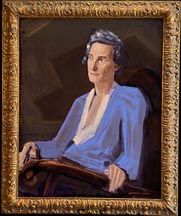
Portrait of Mary Buff
(Scroll down for an article
about Mary and Conrad Buff)
|
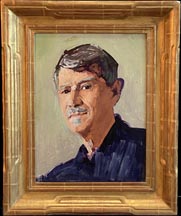
Self Portrait, double sided |
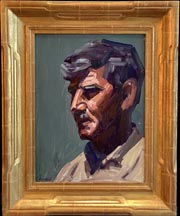
Self Portrait, double sided |
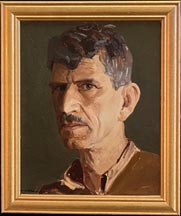
Self Portrait |
Born in Switzerland in 1886 and having spent his later teen years studying art in Munich, Conrad Buff came to the United States as a talented nineteen year old. |
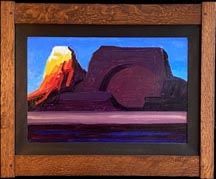
Sunlit Face-SOLD |
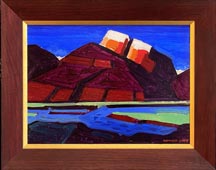
Mountain River |
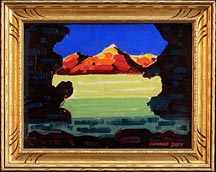
From a cave |
In his first year in America, he spent some time doing odd jobs, herding sheep in a Swiss speaking region of Wisconsin, cooking in cafes and bartending. As his English improved, he quickly made his way west.
At at age twenty-one, he arrived in Los Angeles and met some artists who turned into life long friends. Among these were Maynard Dixon, eleven years his senior, and Edgar Payne, three years older.
We later learned from Joshua Meador's widow, Libby Meador, that Conrad Buff was very helpful to the younger Meador after he arrived in Los Angeles in 1936. Mary and Conrad Buff became close friends with the Meadors thereafter.
Regarding Edgar Payne here's an interesting story. Buff met Edgar Payne and worked for him in 1917. Payne was asked by the Congress Hotel in Chicago to provide murals for all eleven floors of their new hotel. To get the job done, he and his artist wife Elsie Payne hired other artists, Jack Wilkerson Smith, Peter Nielsen, and Grayson Sayer. They rented a warehouse in the town of Tropico (now Glendale) near Eagle Rock, California. In Eagle Rock, a young artist named Conrad Buff heard of the project and applied for an assistant's position at $3.50 per day. Buff would stretch the canvases. Payne would then sketch out the painting. Buff would paint the sky and clouds, Payne and Smith would paint the foreground, Neilsen painted garlands and garlands of flowers, and Sayer and Payne would finish the foreground. By the end of the job, Buff was making $5.00 a day, eleven hundred square yards of muslin were used, and ten thousand pounds of white lead paint.
By the age of forty, Conrad Buff had established himself as a notable artist of strikingly-constructed mountain and desert landscapes of the Southwest, with special attention given to minimal design elements. Today his paintings hang in the Los Angeles County Art Museum, the Oakland Museum, the San Diego Art Museum and others.
Sources: Libby Meador and George Stern, The Art and Life of Conrad Buff, 2005 conversation with Libby Meador, 2005; Askart
|
Below... an article about Mary and Conrand Buff from our November 2012 Newsletter
|
Mary & Conrad Buff, Author and Illustrator,
Newberry and Caldecott Medal Nominees |
Long before Mary and Conrad Buff teamed together to write great books for children, they both made significant marks in the world of fine art.
Mary (1890-1970) studied at the Chicago Academy of Fine Arts and the Cincinnati Art Academy as well as with painter Birger Sandzen. After a short stint of teaching in Idaho, Mary arrived in Los Angeles in the early 1920's, she served as an assistant curator at the Los Angeles County Museum of Art. In 1922, she met and married a local painter, Conrad Buff.
Conrad Buff (1886-1975) left his Swiss homeland at age 16, arriving in the United State in 1902, speaking no English. After a time working as a farm worker in a Swiss section of Wisconsin's dairy country, he made his way west, and never looked back. He arrived in San Francisco shortly after the 1906 earthquake, and soon headed south to Los Angeles. He paid his expenses by painting houses and eventually enrolled as an art student at the Art Student's League in Los Angeles. By the 1920's, Conrad was in his early thirties, and his painting was beginning to receive attention in portraiture and landscape painting. In 1922 when he was thirty-six, he met and married thirty-two year old Mary Jordan Marsh.
|
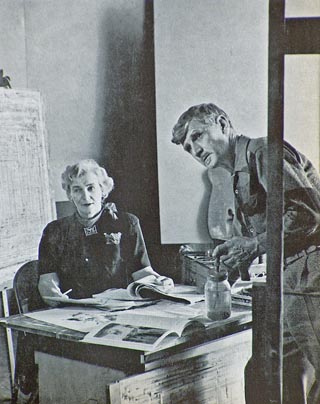
Mary and Conrad Buff,
pictured in Painters of the Desert by Ed Ainsworth. |
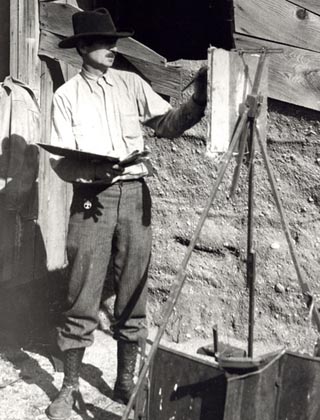
Maynard Dixon at his easel,
back against
weathered western structure |
Not much is written of Mary Buff's painting career, except that she enjoyed painting Indian subjects. Although no auction record yet exists for her paintings, she was an accomplished painter and was a member of the California Art Club and the Laguna Beach Art Association. Ed Ainsworth in his book, Painters of the Desert wrote, "She (Mary) decided that one artist in the family was enough, so she herself gave up painting, and from this unselfish resolve, there came a rewarding success story. The team of Mary and Conrad Buff, writer and illustrator of children's books, evolved."
Consider that Conrad's life began in the breathtaking Lake Constance region in the Appenzell Province of Switzerland. Conrad's first visions of landscape included snow capped mountains and glaciers draining down into green meadows with cattle. As a child, he felt compelled to put this compelling scenery into pictures. But his home life and his relationship with his parents did little to nurture his natural artistic yearnings. At age 14, his father guided him into an apprenticeship at a bakery. Mixing raisins, currents, flour and wheat over long hours and hot ovens was not Conrad's idea of a good time. He lobbied his parents for a life in art, and a compromise was reached. Conrad would learn to be a Swiss lace designer. His father argued it was a way to be in art without starving. Conrad studied arts and crafts in Munich, but knew lace designing was not for him. At
|
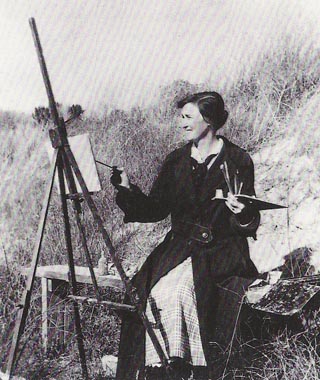
Mary Buff at her easel, painting a scene
while looking into the light |
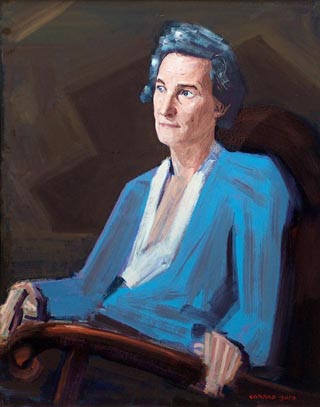
Conrad Buff, Portrait of Mary Buff
Available through Bodega Bay Heritage Gallery
LINK
|
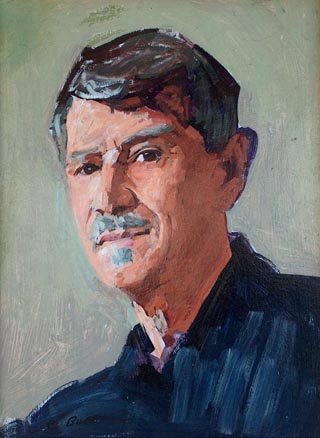
Conrad Buff, Rare double sided Self Portrait
Available through Bodega Bay Heritage Gallery
LINK |
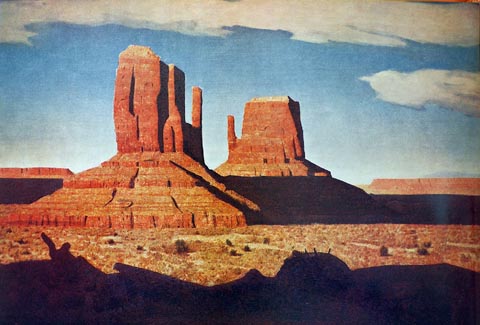
Conrad Buff painting of Monument Valley's Mittens,
cover art for Painters of the Desert by Ed Ainsworth |
age 19, he left Switzerland, his parents, and lace design behind, and headed to America with lots of hope and determination combined with no money, no English skills, no friends, and no contacts.
His first idea was to head to a part of America where Swiss-Americans could help him. He made his way to a Swiss dairying region in southwest Wisconsin. But this idea didn't pan out. The established Swiss dairymen were all too willing to provide him long hard hours with little pay, with the only advantage of hearing his native language. The work was exhausting, and left him little time for art. He soon made up his mind to try a different part of America, and the young man headed west. It took him ten years to get to Los Angeles. Along the way, he was a cowboy, a railroad worker, mule skinner, shepherd, and house painter.
|
He was most moved by the scenery of the west, especially the vast solitude of the desert, its vast mesas, plunging red cliffs and how light and shadow danced with massive geologic forms.
As World War I was ending around 1918, an opportunity came to Conrad. Artist Edgar Payne had been commissioned to paint hallway murals of outdoor scenes. Payne decided to rent an empty piano factory in Tropico, California and hire artists to work on an assembly line basis. Payne hung up 100 foot long sheets of muslin and sketched out the scenes filled with trees, flowers, lakes, mountains and clouds. Then Payne's helpers went to work. Fred Sayer painted foreground, Jack Wilkinson Smith painted trees, Peter Nielsen painted flowers, and Conrad Buff painted mountains and clouds. With a little money in his pocket, he made his way to the Eastern Sierra and the Owens Valley and to Arizona and made his transition to becoming a serious landscape artist.
As his painting career was taking off, he met and married Mary Marsh. The couple married in 1922. Conrad's career included some commissions for murals for the new Edison Building in Los Angeles, and for banks in California and Arizona.
|
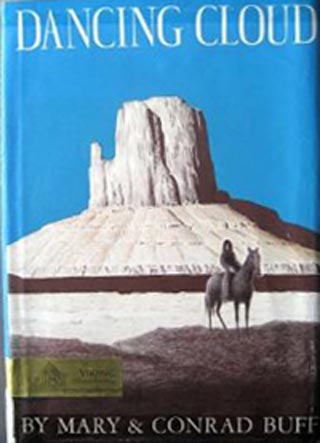 |
Then came the depression, a setback for the Buffs and for everyone else. But at this time, he met artist Maynard Dixon. Dixon was born in 1875, eleven years older than Buff. Dixon was impressed by Conrad's style and the locale of some of his paintings. As it turned out, Buff had painted in some of the same locales Dixon had painted, and both were amazed at how they saw different things and the striking differences in the paintings they produced. Dixon soon bought property in Utah where he made his home the rest of his life, and the Buffs were frequent visitors.
From these trips came the idea to write children's books of the Navajo. Mary was a teacher and needed material for her classroom. It wasn't long before Conrad had been enlisted as Mary's illustrator.
|
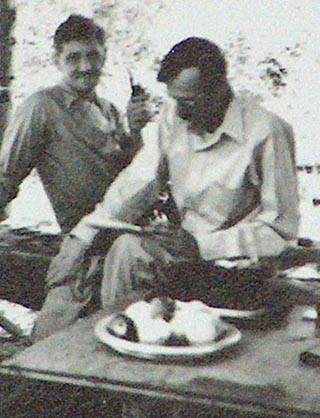
Conrad Buff and Maynard Dixon at Table |
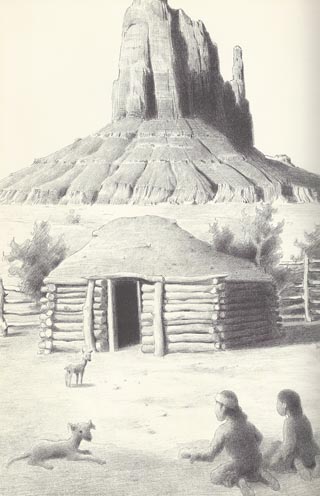 illustration from Dancing Cloud illustration from Dancing Cloud |
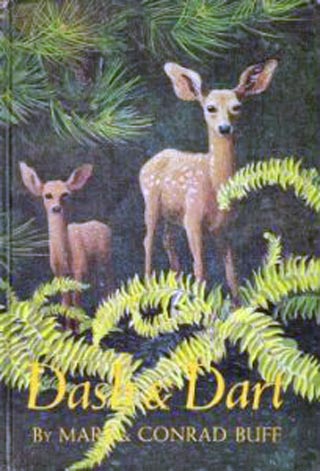 |
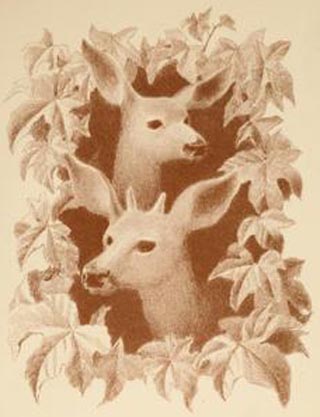
illustration from Dash and Dart |
Their first book was entitled Dancing Cloud, 1937. Now Conrad's seemingly wasted wandering years through the west kicked in. He avidly drew his recollections of Indians, hogans, sheep, burrows, and scenes of the Navajo land. Mary wrote the text first, and then Conrad added art which was integrated with Mary's narrative. The book was quite popular and received high critical praise. Over the next quarter century, Conrad and Mary would write thirteen more books. In 1943, Dash and Dart received a nomination for the Caldecott Medal for illustration. In 1947, 1952, and
|
1954, Mary's narrative was nominated for the Newberry Medal for The Big Tree, The Apple and the Arrow, and Magic Maize.
Dash and Dart (1943) told the story of twin fawns exploring their forest home. The artwork was done in sepia, very soft drawings of wildlife, butterflies, squirrels, and deer. The rhythmic prose tells the tale of Dash and Dart, brother and sister fawns. They are drawn as real deer, no suggestion of human attributes or dialogue. With respect and childlike innocence and sensitivity, it spoke to children as they too explored the wondrous world around them.
The Big Tree (1947) told the age- old story of a three-thousand year
|
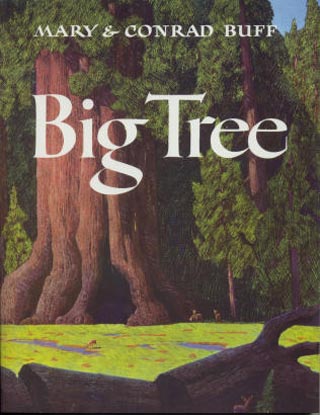 |
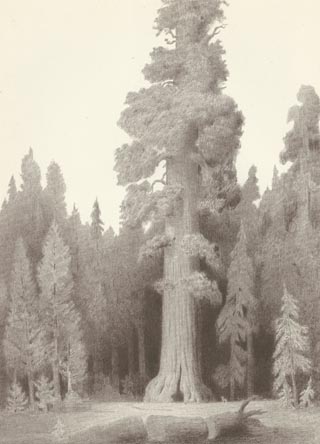 |
old sequoia tree named Wawona, from the time long ago when it was a seed packed into a small cone to the present giant 300 foot tall, having survived twenty-five centuries of attacks from enemies, the most threatening from man and his swinging axes. Then in the last pages of the book, two horsebacked conservationists ride far below Wawona's towering heights and have a conversation, with one of the men reflecting, "I'll never forget what John Muir said about these trees when he was pleading for them to be saved, 'Through all the eventful centuries since Christ's birth, God has cared for these trees, saved them from drought, disease, avalanche and a thousand storms. It is left to the American people to save them from the sawmills.'"
The Apple and the Arrow (1952) takes place in 1291 A.D. high in the Swiss Alps, and is an interpretation of the William Tell legend. Walter and his family live among the towering peaks and make their living herding goats. But circumstances resulting from the Swiss revolution against their occupying Austrian overlords places Walter's father in a difficult predicament as he is ordered to aim and shoot the apple off his son's head with his great crossbow. This story has thrilled children challenging their sense of bravery, honor, and resolve for centuries, and the Buffs bring their narrative and illustrative skills to enliven the tale again.
|
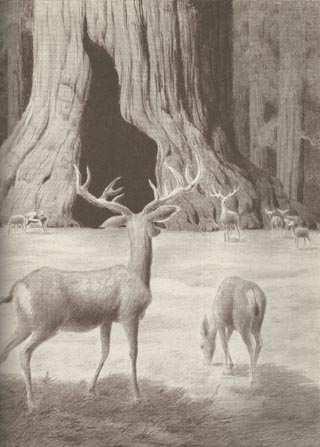 |
Magic Maize (1954) tells the story of a Mayan Indian boy who comes upon a rare piece of jade while he is secretly planting "magic maize." The piece of jade leads to a series of adventures and in the end, even Fabian's father is convinced that the "old and the new" can live in peace.
Conrad and Mary Buff made their home in Eagle Rock, California. Their son, Conrad Buff III and their grandson, Conrad Buff IV were famous in their own right, both extending the family's artistic endeavors. Conrad Buff III was a noted Los Angeles architect, and among his many projects, he built a home for his parents in Eagle Rock. Conrad Buff IV worked as a film editor, winning an Oscar for his work on Titanic in 1998.
|
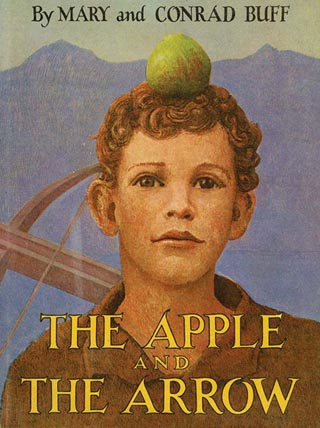 |
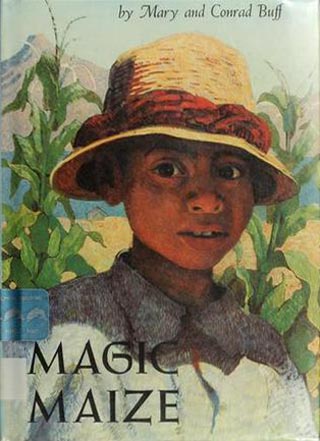 |
Conrad and Mary Buff enjoyed many friends from the artistic community in Los Angeles. During a 2005 visit to Bodega Bay Heritage Gallery, Libby Meador, widow of Disney artist Joshua Meador, had high praise for both Conrad and Mary Buff for their warm welcoming when the Meadors arrived in Los Angeles in 1936 and for their long friendship.
|














 illustration from Dancing Cloud
illustration from Dancing Cloud





